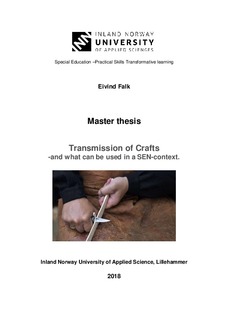| dc.description.abstract | There are rapid changes in our society in how the market relates to crafts. The industrial and digital revolution challenge us to bring new arguments to the table. The educational system has an ongoing debate regarding how crafts education should be organized in the future. There is a growing understanding for the use of practical crafts in a SEN-context as a therapeutic and formative tool, and for the impact of the UNESCO 2003-convention for Safeguarding the Intangible Cultural Heritage.
The aim of this thesis is to understand the transmission of practical crafts, both from a theoretical point of view, and from the practical side. It also intend to explore transmission in a SEN-context, and examine the material as a whole in order to see what can be learned. The research question, how to understand transmission of practical crafts, from a theoretical and a practical view, and in a SEN-context, evolved through an exchange with Otto Salomon, Jon Bojer Godal, Richard Sennet, Nicola Wood and Michael Polanyi who are theoretical sources for understanding the transmission of crafts. For the SEN-context Aric Sigman has been important. The request for research was approved by the NSD – Norsk senter for forskningsdata AS.
This thesis investigates three institutions; The Ruskin Mill Trust and Ringsaker AO centre, which both are experienced within the SEN-context, and the Norwegian Crafts Institute.
In total seven interviews were completed. The first three interviews with craftspeople who are all recognized as masters in their field. Also two learners and two teachers who work within a SEN-context, were interviewed. An interview guide was designed in order to ensure all the specific areas are investigated during the interview sequence
This thesis explores and describes methodology and structure for transmission of crafts, and based on the material it suggests recommendations for the future. Furthermore this thesis shows why our society need crafts; In schools, special education, therapy, for well-being and as a part of our cultural heritage, our life. Finally this thesis shows how transmission of crafts can have a strong positive impact on people with special needs, and a true formative effect. | nb_NO |
